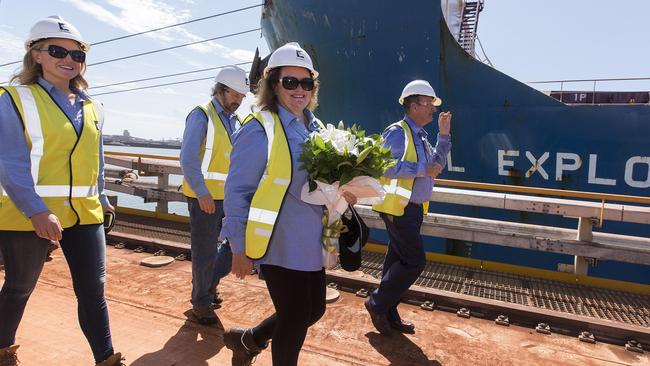Roy Hill’s first shipment to China arrives next week
The first shipment of iron ore from Gina Rinehart’s $10 billion Roy Hill mine arrives in China next week

The first shipment of iron ore from Gina Rinehart’s $10 billion Roy Hill mine arrives in China next week, another milestone in a project that began more than 20 years ago.
The shipment from the Roy Hill mine in Western Australia is being delivered to the port of Caofeidian, 200km southeast of Beijing, under a long-term contact with one of China’s largest steelmakers, Shougang International, signed four years ago.
“It’s a pretty exciting time for us,” Roy Hill’s chief financial officer, Garry Korte, told The Australian.
“We had our first shipment of ore in December. It went to Posco in South Korea where it is already being used to make steel.
“Now we are approaching our next milestone which is the first shipment to arrive in China.
“A lot of people have worked very hard over the past few years and it is very pleasing to see the production finally coming through.”
Chinese buyers, including the state-owned Shougang, are expected to take some 25 million tonnes a year of Roy Hill’s projected production of 55 million tonnes a year.
Roy Hill says the project is expected to be operating at full capacity by the end of the year.
“China is very important to us,” Mr Korte said.
“Chinese banks have participated in the financing of the project in a very big way.”
The $US7.2 billion financing package for the project finalised two years ago included a $US58m tranche in Chinese yuan, one of the first finance deals for a mining project using the Chinese currency.
“A lot of the equipment for the project was also bought from China,” Mr Korte said.
He said Roy Hill Holdings was “very comfortable” with current iron ore prices because Roy Hill was a low-cost producer of high-quality iron ore. “Commodity prices will always be volatile,” Mr Korte said.
“There is always overshoot on both the upside and the downside.
“We are very comfortable where they are at the moment.”
Mr Korte said China’s One Belt, One Road strategy of encouraging infrastructure investment in Asia would help to maintain demand for steel in the region.
This would be assisted by the establishment this year of the Beijing-based Asian Infrastructure Investment Bank, which will provide financing for new infrastructure projects in Asia.
“We see a very positive future for steel in the Asian region,” he said.
He said recent comments by Chinese leaders that they were prepared to use monetary policy to support the housing sector had also helped the iron ore price.
Mr Korte said the development of an iron ore futures market in China had caused volatility in prices in recent times. But he said the iron ore market in China was now “back in a position of balance”.
“We haven’t seen iron ore stockpiles in China growing recently. All the product which is coming from Australia is being used and turned into steel.”
The Roy Hill iron ore mine was initially pegged more than 20 years ago by Mrs Rinehart’s company Hancock Prospecting. Financing for the project was completed near the top of the iron ore market in early 2014 when prices were above $US100 a tonne.
The slowdown in the Chinese economy saw the price fall to a low of $US39.30 in early January but the market has since recovered to about $US55 a tonne.
While most Australian iron ore sales to China are made under long-term contracts, they are set at market prices.
Roy Hill shareholders include Japan’s Marubeni, Posco and Taiwan’s China Steel.
Three shipments have gone to South Korea from Roy Hill though Port Hedland. The first shipment to Taiwan arrived earlier this week, met by Roy Hill’s chief executive Barry Fitzgerald.
Mr Korte said Roy Hill was “very confident in China in the long term”.
“There will be some bumps along the road but there is still a lot of urbanisation to take place in China. There is a very large population base in China and in Asia with countries such as India and Indonesia all moving down the path to increasing living standards and giving people a decent home to live in.”
“If you take a 20 to 30 year view, I see a very bright outlook for iron and steel.”


To join the conversation, please log in. Don't have an account? Register
Join the conversation, you are commenting as Logout